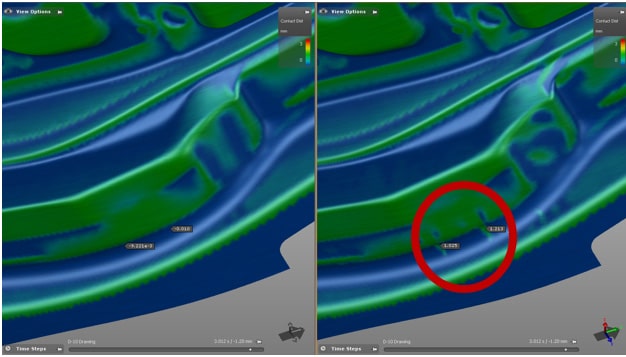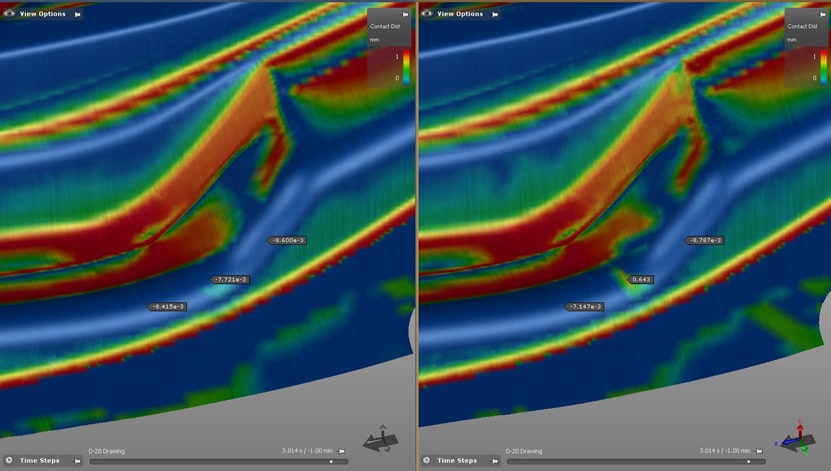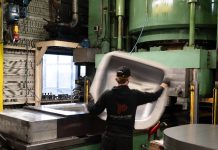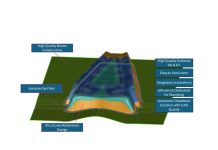Predicting Wrinkles for Door Inner Parts Using the TriboForm Software
In this anonymous blog post, one of the largest Chinese tool makers shares their results from a series of five case studies conducted using TriboForm’s friction model to enhance their sheet metal forming simulations. Recently, issues occurred in tryout and production, in which they could not predict wrinkles in their initial sheet metal forming simulations. See how AutoForm plus TriboForm’s Plug-In results in improved predictability of wrinkling issues seen in reality.
This is an anonymous case study from one of the largest toolmakers in China and the world, which supplies tools to reputable OEMs and Tier 1 suppliers. This toolmaker provides sophisticated tools meeting high quality standards for its customers in China and beyond, such as Audi and Volkswagen.
Recently, their forming simulations with default settings only showed some areas for potential wrinkling but the values were very small, indicating a very low risk for wrinkles to occur in reality. The engineers therefore released the data to their colleagues to manufacture the die for tryout.
Unfortunately, what they simulated with their default settings was not what they saw in reality. They were facing severe wrinkling issues for door inners and several other parts for different OEM customers (Fig. 1). Wrinkles kept occurring at certain locations in the parts, while the forming simulations predicted a “safe result” from the unspecified- accuracy aspects.

Fig. 1: The wrinkling on the parts.
Mr. Li from the toolmaker said, “The wrinkling issues were considered as a serious issue for their product quality. At first, we checked their input parameters and examined the blank size and binder force. Everything seemed right. Next, according to the tool buy-off requirement, the gap of the die was increased by 0.5 mm in the simulation process to follow real production strategy, but still the simulation results with the limited constant friction model did not show serious wrinkle like the tryout results.”
Meanwhile, without correlation from the simulation, their tryout tool shop had no choice but to improvise based on their practical experience. For instance for one door inner, an additional draw bead could provide sufficient resistance to solve the wrinkle issues (Fig. 2). This was successful, however it required a costly re-cut of the die on the CNC machine.

Fig. 2: An additional draw bead could reach sufficient resistance to solve the wrinkles in the door inner
Since this was a re-occurring challenge for several parts for several of their OEM customers, this toolmaker launched a project to discover the root cause of these issues. Previous studies have shown that friction and lubrication conditions are also critical factors on the quality of parts, especially certain materials and parts are highly sensitive to tribological conditions. Furthermore, one important aspect of simulation accuracy is to describe the tribological behavior of the process as much as possible based on a physically-meaningful settings in the simulation. Therefore, this toolmaker and our AutoForm China office ran new simulations using the TriboForm friction model. TriboForm enables metal forming simulation software to replace the outdated constant coulomb coefficient with a four-dimensional friction model as a function of contact pressure, velocity, strain and temperature.
In addition, TriboForm enables users to access a database of friction cards correspondent to the tribology related material data, visualize friction coefficients, and export the results for stamping simulations. The approach for the five case parts was to utilize the enhanced description of friction and lubrication conditions in their existing forming simulations. So, in this study a TriboForm friction model from available default libraries was utilized without having to do any specific tribology test or customization for the used materials. The below images show the simulation results with and without the TriboForm friction models for two of the parts.

Fig. 3: While no wrinkle could be predicted using Coulomb friction model (left), TriboForm simulation showed that there were wrinkles 1.0 mm in two places (right).

Fig. 4: While no wrinkle could be predicted using Coulomb friction model (left), TriboForm simulation showed that local wrinkles of 0.64 mm were generated (right).
Christoph Weber from AutoForm China said, “During this project, our customer and AutoForm together identified friction as the root cause of these reoccurring wrinkle issues across all analyzed parts for different OEM customers. By applying TriboForm’s advanced friction model to simulate real behavior, we could reliably predict and solve the wrinkles for all five parts like tryout and mass production forms. And all of this was done without any additional material or friction tests, since we simply used tribology files from TriboForm’s standard library! This means, without additional effort in engineering, can we solve these wrinkles already in the digital engineering phase and therefore avoid costly re-milling in the physical tool tryout.”
Business case: One tryout loop costs approximately CNY 37,900, based on 1 day re-engineering at 1,000 CNY/day labor cost, 3 days re-milling at 300 CNY/hour, 3 days die spotting and tryout at 500 CNY/day labor cost with three persons, and 150 CNY/hour tryout press costs. Using TriboForm plugin with its standard tribology library for the five door inner parts of this project, results in a return-on-investment (ROI) of 790% based on just one reduced tryout loop per part.
![]()
Implementing TriboForm’s Analyzer for comprehensive friction modelling and four TriboForm-plugins for efficient simulation of all door inner and outer projects at this toolmaker would even result in over 800% ROI.

In conclusion, TriboForm can help this toolmaker to identify the root cause of their reoccurring wrinkle issues and reliably predict and solve them, saving at least one tool tryout per door project. The implementation would increase this toolmakers’ profitability with an ROI of over 800% and cut the delivery time of high quality tools for their OEM customers by several weeks.













